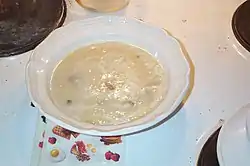Potage
Potage (/ˈpɒtɪdʒ, poʊˈtɑːʒ/, also UK: /pɒˈ-, pəˈ-/, French: [pɔtaʒ] (![]() listen); from Old French pottage 'food cooked in a pot') is a category of soups, stews, or porridges, in which meat, vegetables, grains, fruit, or a combination of those ingredients are boiled together with water, broth, or other liquids.[lower-alpha 1]
listen); from Old French pottage 'food cooked in a pot') is a category of soups, stews, or porridges, in which meat, vegetables, grains, fruit, or a combination of those ingredients are boiled together with water, broth, or other liquids.[lower-alpha 1]
 A potage soup prepared with potato and truffle | |
| Type | Soup, stew, or porridge |
|---|---|
| Main ingredients | Meat, vegetables |
History
Potage has its origins in the medieval cuisine of northern France and increased in popularity from the High Middle Ages onward. A course in a medieval feast often began with one or two potages, which would be followed by roasted meats.
European cottage gardens often contained a variety of crops grown together. These were called potage gardens by the French, as the harvest from that garden was used to make potage.[1]
The earliest known cookery manuscript in the English language, The Forme of Cury, written by the court chefs of King Richard II in 1390,[2] contains several potage recipes including one made from cabbage, ham, onions and leeks.[3] A slightly later manuscript from the 1430s is called Potage Dyvers ("Various Potages").[4] The word "pottage" is used in the earliest English translations of the Bible, in relation to the lentil soup for which Esau trades his birthright in Genesis 25:29–34; from this story, the phrase "mess of pottage" means something attractive but of little value being exchanged for something much more important. During the Tudor period, a good many English peasants' diets consisted almost solely of potage. Some Tudor-era people ate self-cultivated vegetables like cabbages and carrots and a few were able to supplement this from fruit gardens with fruit trees nearby.
Some potages that were typical of medieval cuisine were frumenty, jelly (flesh or fish in aspic), mawmenny (a thickened stew of capon or similar fowl), and pears in syrup. There were also many kinds of potages made of thickened liquids (such as milk and almond milk) with mashed flowers or mashed or strained fruit.
According to Catalonian religious customs, if a fiesta doble (a "double feast" in the church) fell on a meat day two consecutive potaje courses were served, one of which would be a cheese-topped rice or noodle dish, the other a meat stew (Catalan: guisado) cooked in "salsa" made from wine, vinegar, parsley, spleen, liver, saffron, egg yolks and assorted spices. Two potaje courses were also served for fish days, first high-quality spinach from the monastery gardens topped with peppers, or cabbage or lettuce (if spinach could not be found), followed by either a bowl of semolina or noodles or rice cooked in almond milk, or a grain bowl of semolina groats seasoned with cinnamon.[5]
Notes and references
Informational notes
- "potage" Trésor de la langue française informatisé; "potage". Lexico UK Dictionary. Oxford University Press.; "pottage". Lexico UK Dictionary. Oxford University Press.
References
- From puritanical to pleasurable: Potage not as challenging or exotic as it sounds. The America's Intelligence Wire. June 19, 2004
- "The Forme of cury - Pygg in sawse sawge". www.bl.uk. The British Library. Retrieved 30 January 2015.
- Smith, H. (1900s). The Master Books of Soups. London: Spring Books. p. 170. Note: More information about The Master Books of Soups from: Google Books and Internet Archive.
- "Potage Dyvers - Contents". www.bl.uk. The British Library. Retrieved 30 January 2015.
- Pedralbes. Universidad de Barcelona.
.jpg.webp)